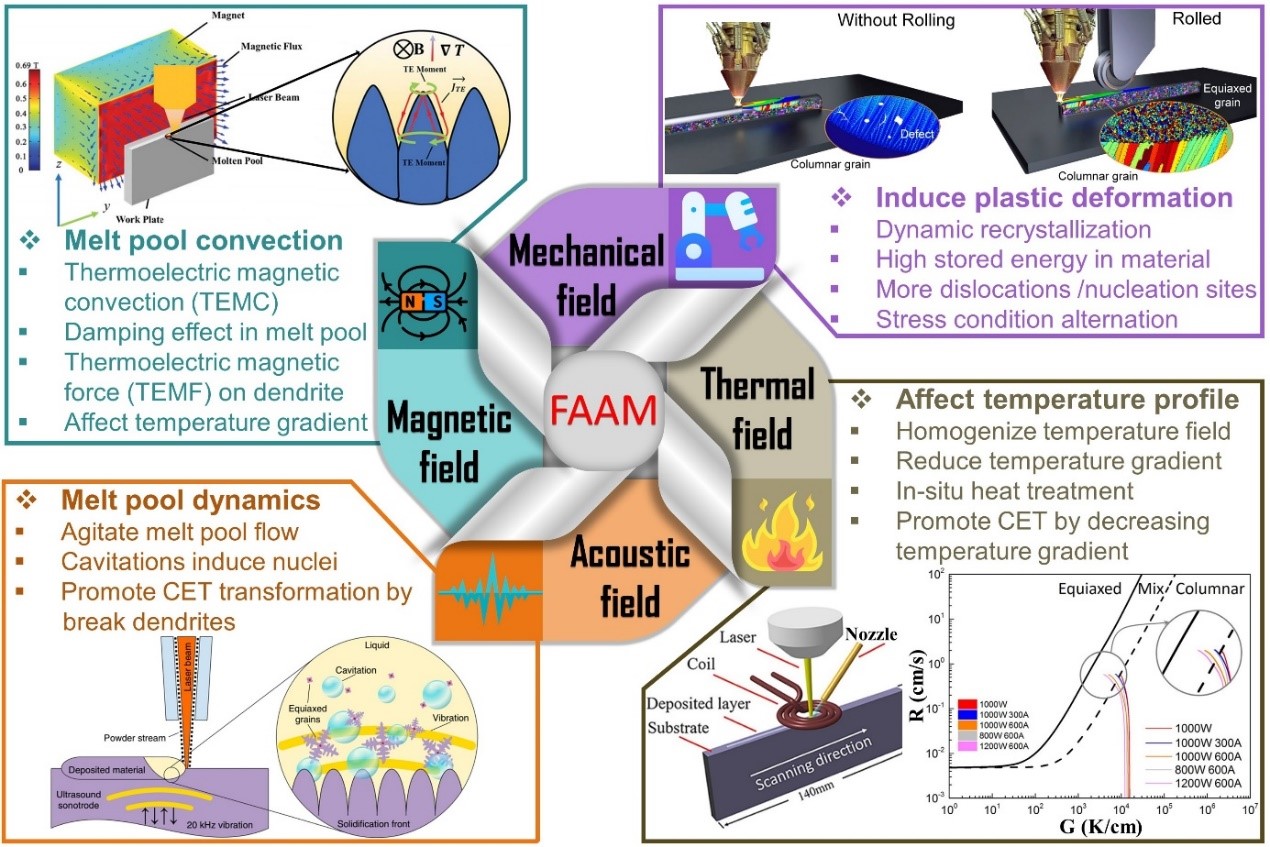As a new type of material processing technology, additive manufacturing has many advantages, such as short manufacturing cycle, high material utilization rate and ability of complex products structure processing, etc. However, there are still many issues such as limited selection of alloy grades, obvious anisotropy of material properties, difficulty in controlling structural defects, low production efficiency, and high roughness. These issues have attracted widespread attention and research from researchers. Magnetic field, as a non-contact physical energy field, can affect the physical changes and chemical reaction processes in the preparation of metal materials, and is therefore used to control the changes or reaction processes involved. Prof. Anping Dong and Assistant Prof. Dafan Du from the Institute of Solidification Science and Technology, School of Materials Science and Engineering, Shanghai Jiao Tong University have made a series of progress in this field. Recently, the team collaborated with multiple domestic and foreign research institutions to publish a lengthy review of "Review on field assisted metal additive manufacturing" in the top journal of Mechanical Engineering, International Journal of Machine Tools and Manufacture (Immediate impact factor of 12.858). The full text consists of 35000 words and is currently the most comprehensive review of this research field, covering the effects of magnetic field, sound field, temperature field, mechanical field, electric field, and coupling field on the manufacturing process of metal additives. Guiding suggestions are also provided for external field assisted metal additive manufacturing. Paper link: https://doi.org/10.1016/j.ijmachtools.2023.104032.

Prior to this, the team explored the mechanism of solidification microstructure evolution and mechanical properties changes during the selective laser melting process of AlSi10Mg alloy under a static magnetic field. It was found that applying a 0.12 T static magnetic field can lead to a decrease in dendrite spacing in the melt pool, refine grains, reduce pores, and improve the mechanical properties of AlSi10Mg alloy. The above results are published in Materials and Design (Impact Factor 9.417) under the title of Influence of static magnetic field on microstructure and mechanical behavior of selective laser melted AlSi10Mg alloy. Link: https://doi.org/10.1016/j.matdes.2019.107923. Furthermore, the team explored the evolution mechanism of micro melt pool morphology and flow field within a large energy density range during the selective laser melting process under static magnetic field through a combination of numerical simulation and experiments. The research results indicate that, within a certain range, the static magnetic field as an external physical field can affect the solidification of the micro melt pool during the selective laser melting process. The multi-scale thermal electromagnetic effect of the magnetic field helps to improve the laser absorption rate and the density of the printed piece; The thermoelectric magnetic effect at the dendrite scale leads to grain refinement and ultimately improves the mechanical properties of the material. The relevant research results, titled "Promoting the identification and grain refinement with assistance of static magnetic field in laser powder bed fusion," were accepted by the International Journal of Machine Tools and Manufacture. Paper link: https://doi.org/10.1016/j.ijmachtools.2022.103965.

In addition to the discovery of a new mechanism for the Laser powder bed fusion process assisted by a static magnetic field, the team also utilized a static magnetic field assisted Laser Direct Energy Deposition (LDED) to fabricate Ni-based superalloys, and revealed the influence of a static magnetic field on the flow and microstructure evolution of the molten pool. The relevant research results are published in the traditional journal Metallurgical and Materials Transactions A in the field of metal metallurgy, titled 'Influence of static magnetic field on the microstructure of Nickel based superalloy by Laser directed energy disposal'. Paper link: https://doi.org/10.1007/s11661-020-05783-4.

Under the leadership and support of Prof. Baode Sun, the academic leader of the Institute of Solidification Science and Technology at the School of Materials Science, the team conducted cutting-edge exploration on the basic scientific issues of additive manufacturing micro melt pool solidification. The relevant research results can provide a deeper understanding of the additive manufacturing process from the perspective of rapid melting in the melt pool, providing theoretical support for the organizational regulation and defect control of additive manufacturing; On the other hand, through the design and modification of magnetic field assistance for additive manufacturing equipment, new ideas are provided to improve the comprehensive mechanical properties of metal additive manufacturing components.
The above related research has been supported by projects and units such as the National Natural Science Foundation of China (No. 52071205), the Oceanic Interdisciplinary Program of Shanghai Jiao Tong University, AVIC Shanghai Commercial Aeroengine Manufacturing Co., Ltd., and the 31 Research Institute of the Third Research Institute of China Aerospace Science and Engineering Group.
